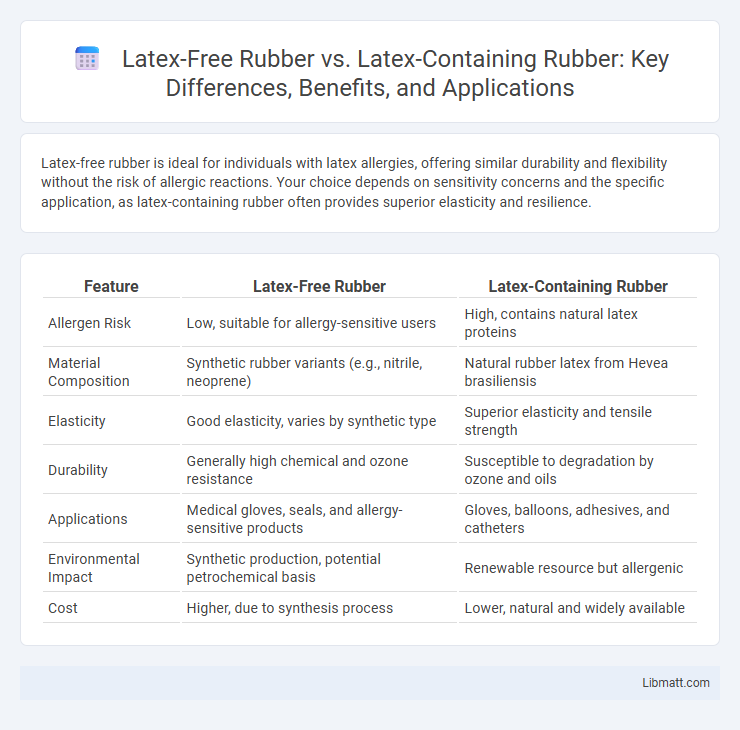Latex-free rubber is ideal for individuals with latex allergies, offering similar durability and flexibility without the risk of allergic reactions. Your choice depends on sensitivity concerns and the specific application, as latex-containing rubber often provides superior elasticity and resilience.
Table of Comparison
| Feature | Latex-Free Rubber | Latex-Containing Rubber |
|---|---|---|
| Allergen Risk | Low, suitable for allergy-sensitive users | High, contains natural latex proteins |
| Material Composition | Synthetic rubber variants (e.g., nitrile, neoprene) | Natural rubber latex from Hevea brasiliensis |
| Elasticity | Good elasticity, varies by synthetic type | Superior elasticity and tensile strength |
| Durability | Generally high chemical and ozone resistance | Susceptible to degradation by ozone and oils |
| Applications | Medical gloves, seals, and allergy-sensitive products | Gloves, balloons, adhesives, and catheters |
| Environmental Impact | Synthetic production, potential petrochemical basis | Renewable resource but allergenic |
| Cost | Higher, due to synthesis process | Lower, natural and widely available |
Introduction to Rubber Types
Latex-free rubber is synthesized without natural latex proteins, reducing allergy risks and providing enhanced chemical resistance compared to latex-containing rubber, which is derived from the sap of rubber trees and contains natural latex proteins. Latex-containing rubber offers superior elasticity and tensile strength, commonly used in medical gloves, balloons, and adhesives. Selecting between latex-free and latex-containing rubber depends on application requirements, allergy concerns, and performance characteristics.
What is Latex-Containing Rubber?
Latex-containing rubber is a natural material derived from the sap of the rubber tree, Hevea brasiliensis, composed primarily of polyisoprene. It is widely used in products like gloves, balloons, and medical devices due to its elasticity and durability. If you have latex allergies, opting for latex-free alternatives is crucial to avoid allergic reactions.
Understanding Latex-Free Rubber
Latex-free rubber is composed of synthetic materials such as nitrile, neoprene, or vinyl, designed to provide similar elasticity and durability without the proteins found in natural latex that cause allergic reactions. Understanding latex-free rubber is essential for individuals with latex sensitivities or allergies, ensuring safe use in medical gloves, balloons, and various consumer products. Your choice of latex-free products can prevent adverse reactions while maintaining effective barrier protection and flexibility.
Key Differences Between Latex-Free and Latex-Containing Rubber
Latex-free rubber is derived from synthetic materials such as nitrile or neoprene, which eliminates the risk of allergic reactions associated with natural latex proteins found in latex-containing rubber. Latex-containing rubber offers superior elasticity and comfort due to its natural polymer structure but poses a significant allergy risk for sensitive individuals. You should choose latex-free rubber products to avoid allergic responses while still benefiting from durable and flexible alternatives in medical or industrial applications.
Common Applications of Latex-Containing Rubber
Latex-containing rubber is commonly used in medical gloves, balloons, and adhesives due to its excellent elasticity, durability, and natural resistance to microbial infections. This material is favored in applications requiring flexibility and a tight, comfortable fit, such as surgical and examination gloves. Your choice should consider potential latex allergies, prompting some industries to switch to latex-free alternatives for safety.
Popular Uses for Latex-Free Rubber
Latex-free rubber is widely used in medical gloves, allergy-safe household products, and food industry applications due to its hypoallergenic properties. Its popularity ensures protection for individuals with latex allergies while maintaining durability and flexibility. Your choice of latex-free rubber reduces the risk of allergic reactions in sensitive environments.
Health Risks and Allergies: Latex Considerations
Latex-containing rubber poses significant health risks due to natural latex proteins that can trigger allergic reactions ranging from mild skin irritation to severe anaphylaxis. Latex-free rubber alternatives reduce the risk of latex allergies, making them safer for individuals with latex sensitivity and healthcare environments prioritizing patient and staff safety. Choosing latex-free rubber products helps protect your health by minimizing exposure to potential allergens without compromising product performance.
Environmental Impact of Both Rubber Types
Latex-free rubber typically has a lower environmental impact due to the reduced risk of allergic reactions and the ability to use synthetic or plant-based alternatives that require less water and land resources compared to natural latex harvesting. Latex-containing rubber, derived from Hevea brasiliensis trees, supports sustainable agroforestry practices but may involve deforestation and pesticide use, impacting biodiversity and ecosystems. Your choice between these rubbers can influence environmental sustainability, with latex-free options often offering improved biodegradability and less ecological footprint.
How to Identify Latex-Free vs Latex-Containing Products
To identify latex-free rubber products, examine the product label or packaging for explicit statements such as "latex-free" or "100% synthetic rubber," as these indicate the absence of natural latex allergens. Latex-containing rubber products often list natural rubber latex or latex on ingredient lists and may carry allergy warnings due to the presence of proteins that can cause allergic reactions. Testing kits and certifications from allergy organizations can also help verify whether a product is latex-free or latex-containing, ensuring safety for individuals with latex allergies.
Choosing the Right Rubber Material for Your Needs
Latex-free rubber offers an excellent alternative for individuals with latex allergies, providing hypoallergenic properties without compromising durability or flexibility. Latex-containing rubber typically provides superior elasticity and is often preferred in applications requiring high tensile strength, such as gloves or medical devices. Understanding your specific needs, including sensitivity concerns and performance requirements, is essential for selecting the right rubber material to ensure safety and functionality.
Latex-Free Rubber vs Latex-Containing Rubber Infographic

 libmatt.com
libmatt.com